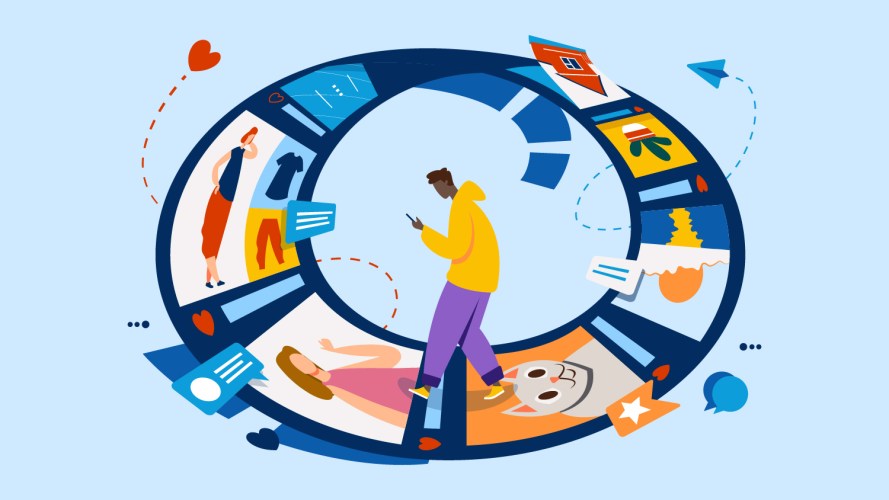How Salesforce Is Using AI For Content Marketing in 2024

Here’s how we’re using generative AI tools — and how we’re not — in 2024. Plus, a peek into the regulations we’ve implemented to keep trust and safety front and center for ourselves and our communities.

Carolyn Warsham
For many content marketing teams, last year started with “What the heck is generative AI?” and ended with “Okay, how can we use this to improve our business?” At Salesforce, 2023 was the year our content marketing team started playing around with generative artificial intelligence (AI). We had fun, and admittedly quite a bit of frustration, as we gained a better understanding of how it can help us be more efficient and creative.
Turns out generative AI is great for some things, like summarizing long documents and helping us break through writer’s block, and less than great for other things, like writing first drafts. And that’s no surprise: These AI tools are in their toddler phase. Would you ask a toddler to throw a javelin? You wouldn’t, at least without adult supervision. The same goes for generative AI.
In other words, we didn’t expect too much from — or rely too much on — generative AI in our content marketing efforts last year. And this year, we’ll continue to give it time to wobble around, fall down, get up again, and show off how it’s growing up, day by day.
AI may be young, but we’re still marching into a year where the majority of content marketers are expected to be using generative AI to support daily writing. In 2024, 7.5 million blog posts will likely publish every day. Yet many experts agree that the brands that continue to harness human ingenuity and authentic voices will stand out in the fray. So, we wanted to share how the Salesforce editorial team is thinking about these potentially game-changing tools for AI in content marketing.
Our aim? To help you answer two of the most important questions content marketing teams are asking right now:
- Where should we try out generative AI tools when it comes to content marketing?
- What kind of guidelines should we be setting around generative AI for our teams?

5 ways Salesforce will continue to use generative AI in content marketing in 2024
1. Brainstorming. In 2023, generative AI helped us break through writer’s block more than a few times, especially for shorter copy like headlines, CTAs, and email subject lines. While we almost never use generative AI outputs verbatim, we love using them to get our editorial team’s creative juices flowing — especially at the end of the day when, let’s be honest, the juice is often totally dried up.
2. Recaps. One of our favorite use cases for generative AI in content marketing? It can provide the main takeaways from an event or interview transcript. When writers upload 25-page documents into generative AI tools, there are audible exhales in home offices everywhere, as, seconds later, a concise summary of the transcript, complete with takeaways and usable quotes, appears on-screen. We conduct and review countless interviews each year, so we predict generative AI will save us considerable time in this regard.
3. Style and grammar checks. Generative AI tools can also tweak copy to make it grammatically correct and more conversational. Our editors don’t always agree with AI’s suggestions, though, so we do have to accept or reject them as part of the process.
4. Atomization. When you place a final draft into a generative AI tool, it can pump out starter social copy, TikTok scripts, and even meme recommendations, in seconds. We foresee using AI more this year to help us atomize our content across multiple channels. Again, for us, it’s absolutely critical to have a human edit this copy so it aligns with our voice and tone, and is authentic and original.
5. SEO optimization support. AI can scour the internet for underused (and potentially popular) SEO keywords. In this sense, it’s a great SEO optimization assistant, and we aim to take advantage of this capability more in the coming year.
So, that’s how we’re using AI in content marketing. We’re intrigued by generative AI’s abilities for all of the above — as always, with a human in charge.
How we’ve created oversight around generative AI in content marketing
Trust has been a core value at Salesforce since the company was founded in 1999. But trust doesn’t have to be in your mission statement for you to understand its importance as generative AI usage (and misusage) snowballs.
Here’s an abridged version of the ground rules we’ve set in place. Feel free to adapt them for your own organization if you find them helpful:
Don’t input personal, or otherwise sensitive information into any AI tool. Why? Anything you put into generative AI is saved forever in the database and could become public.
Fact-check all AI-generated content and claims to ensure accuracy. Generative AI is known to get some things wrong, or “hallucinate,” about 20% of the time. Some outputs may be out of date or otherwise incorrect. Fact-checking all outputs helps ensure that the content you are circulating is reliable, trustworthy, and free of bias and toxicity. (If your team isn’t well versed on fact checking, we recommend that you provide some guidance. Google has several Fact Check tools you might want to check out.)
Check for plagiarism. Many generative AI tools include a feature that checks sources and gives credit to the original sources. It’s important to cite and reference external content generously so that you maintain ethical standards and practices to avoid copyright infringement. (Doing so also ensures that you show up as good citizens of the internet.)
Review the voice and tone. AI content generation tools can be trained on brand voice-and-tone guidelines, but they can’t pick up on the nuances. For example, a tool might generate “conversational” copy like “Hey, TikTok fam!” Chances are you’ll want to rewrite that so it sounds more like you.
Treat generative AI as an assistant — not a replacement for human creativity. We can’t stress this enough: Don’t use AI-generated content verbatim. Instead, use it as a starting point, adding your own voice and relevant information you’ve sourced independently. This will not only improve and differentiate your content, but also safeguard your brand — since AI-generated content may not be eligible for copyright protection.
Add a disclosure. All published content that was supported, in part, with a generative AI-based tool must include the following disclosure: “AI supported the writers and editors who created this article.” By being transparent, we stay true to our #1 value of Trust and reinforce our commitment to the responsible use of AI.
Have you implemented AI in content marketing? We’d love to hear what you think about these use cases and guidelines. Feel free to email me at cwarsham@salesforce.com. By the way, please bookmark this post and check back often. We’ll update this guidance throughout the year as we learn more about how generative AI can support our daily work.
Move faster with AI
Focus on innovation, not repetitive tasks. See how generative AI is transforming marketing.






























